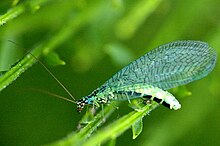| Chrysopinae | |
|---|---|

| |
| Chrysopa perla (Chrysopini) | |
| Scientific classification | |
| Domain: | Eukaryota |
| Kingdom: | Animalia |
| Phylum: | Arthropoda |
| Class: | Insecta |
| Order: | Neuroptera |
| Family: | Chrysopidae |
| Subfamily: | Chrysopinae Esben-Petersen, 1918 |
| Diversity | |
| About 60 genera | |
Chrysopinae is the nominate subfamily of green lacewings in the insect family Chrysopidae in the order Neuroptera. This subfamily is also the largest within the family and comprises about 60 genera.
Members of the genus Chrysoperla and the genus Chrysopa in this subfamily are common in Europe and North America.[1][2] Chrysopinae larvae are predatory and feed on aphids; some of these species have been used in biological pest control, as has the Australian Mallada signatus.[3]
- ^ Shakir, Hafiz Usman; Anjum, Najuf Awais; Ali, Qurban; Saleem, Shahzad; Awais, Muhammad; Anwar, Tauqir (2015). "Molecular systematics of Chrysoperla carnea group (Neuroptera: Chrysopidae) in Punjab, Pakistan". 2015Journal of Global Innovations in Agricultural and Social Sciences. 3 (1): 12–15. doi:10.17957/JGIASS/3.1.677. S2CID 88722322. Retrieved 2022-01-24.
- ^ Brooks, S. J.; Barnard, Peter C. (1990). "The green lacewings of the world: a generic review (Neuroptera: Chrysopidae)" (PDF). Bulletin of the British Museum (Natural History). 59 (2): 117–286. ISSN 0524-6431. Retrieved 10 April 2022.
- ^ New, T.R. (2002). "Prospects for extending the use of Australian lacewings in biological control" (PDF). Acta Zoologica Academiae Scientiarum Hungaricae. 48 (Supplement 2): 209–216. Retrieved 3 February 2011.